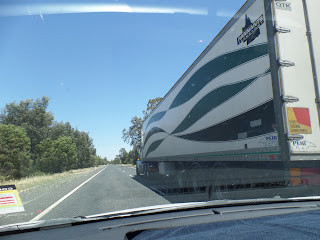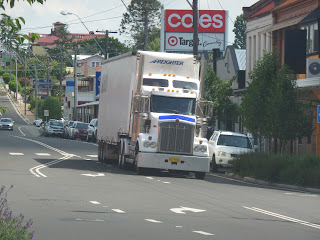Armidale. I always liked reaching this town on the journey from Adelaide, South Australia, to Brisbane, Queensland. It was a relief to know that the dry plains and countryside were behind us, and that in front of us there would be greenness, and often rain too. Comes with the territory.
Our first task in the morning was registering for basic medicare at the CentreLink/Medicare office in Armidale. This took some time as the staff were unsure of the procedure. No doubt there would not be many overseas travellers registering for Medicare in Armidale. Luckily our details were still on the system from our last trip.
The shopping area of Armidale was superb, plenty of thriving shops, large chain stores, and extremely clean paving everywhere. And outside cafes, with planter boxes, on pedestrianised footpaths. Perfectly landscaped. But no time to loiter here, we had to move on to the next town.
Unfortunately, I have no photographs of the huge brick Catholic churches, with equally large brick Catholic schools next door, in Tenterfield and Armidale. Obviously wealthy Catholic communities.
But ever onwards. The road slowly descended, and it was obvious that we were leaving the higher and greener land behind, although the countryside was still pretty hilly.
Next stop on the New England Highway, Tamworth, home of country and western music with the next festival in January 2016. We remember Tamworth as a fairly dry, hot and generally uninteresting city, but during the last thirty years the city centre has had a facelift. As in Armidale, the streets have been paved, buildings spruced up, and trees planted closely together. A cool oasis in which to have a walk, and to drink our morning coffee.
The Australian utility, gone upmarket, with dual cab, and very comfortable seats.
An old brown brick pub, on the corner, also revitalised, without losing its iconic character.
There were benches along both sides of the street, perfect for sitting on, in the shade, for shoppers to have a rest.
Our white Toyoto, parked perfectly by me. I love reverse angle parking, so much easier than parallel parking.
Back on the road again, on the Oxley Highway. We appeared to be out on the plains, it was certainly flatter, and there were some long stretches of straight road, but there were still hills surrounding us, which cannot be seen in the photograph below. No real plains yet.
Our lunch stop, in Gunnedah, at a deserted, dry and hot park by the river. Typical.
The house on stilts, built for air circulation, although in this situation, the stilts no doubt keep the house out of the water when the river floods.
After lunch we headed to McDonalds for our after lunch espresso, and a toilet break. Thank goodness for McDonalds. No town is too small for a thriving McDonalds.
An undulating road, we are not on the plains yet.
One hundred kilometres down the road, we stopped at Coonabarabran. I just love the name. It really rolls off the tongue. We were in need of an ice cream. Just too hot.
The Commonwealth Bank, in an immaculate old building, and newly painted. Glowing against the blue sky.
There were not many people out on the hot streets of Coonabarabran, but the huge road trains thundered through every few minutes.
Coonabarabran was the town chosen for the 1957 film 'Shiralea' staring Peter Finch. A story about a swagman father who found himself in custody of his daughter, and took her with him as he roamed around the countryside.
Back in the car again we drove a further 100 kilometres, to Gilgandra, where we stopped at the Information Centre/Museum. We were certainly not used to driving in the glaring heat. An interesting museum about the history of the area.
We were now driving on the Newell Highway, and continued south to Dubbo. The Newell Highway north travels through the farming areas of Narrabri and Moree until it reaches Goondiwindi. I worked as a 'mother's help' on a station above Goondiwindi, which in 1966 was at the edge of the 'back of beyond'. It was quite an experience, and I really enjoyed life on an outback property.
Finally we arrived in Dubbo, to a comfortable motel, and huge meat meals at a local pub. People certainly love their meat in this country.
Another very hot day, in the mid thirties.


















































